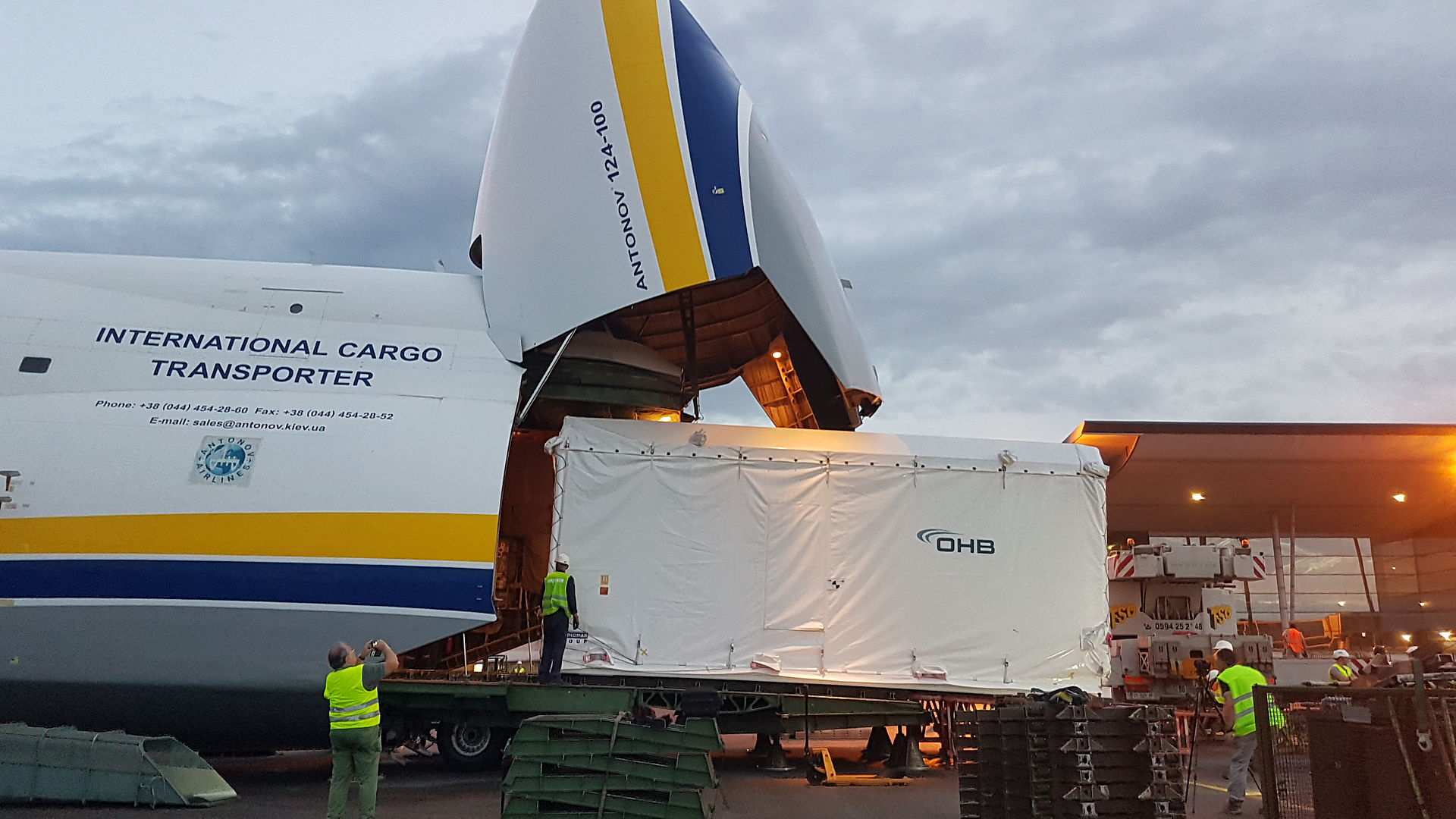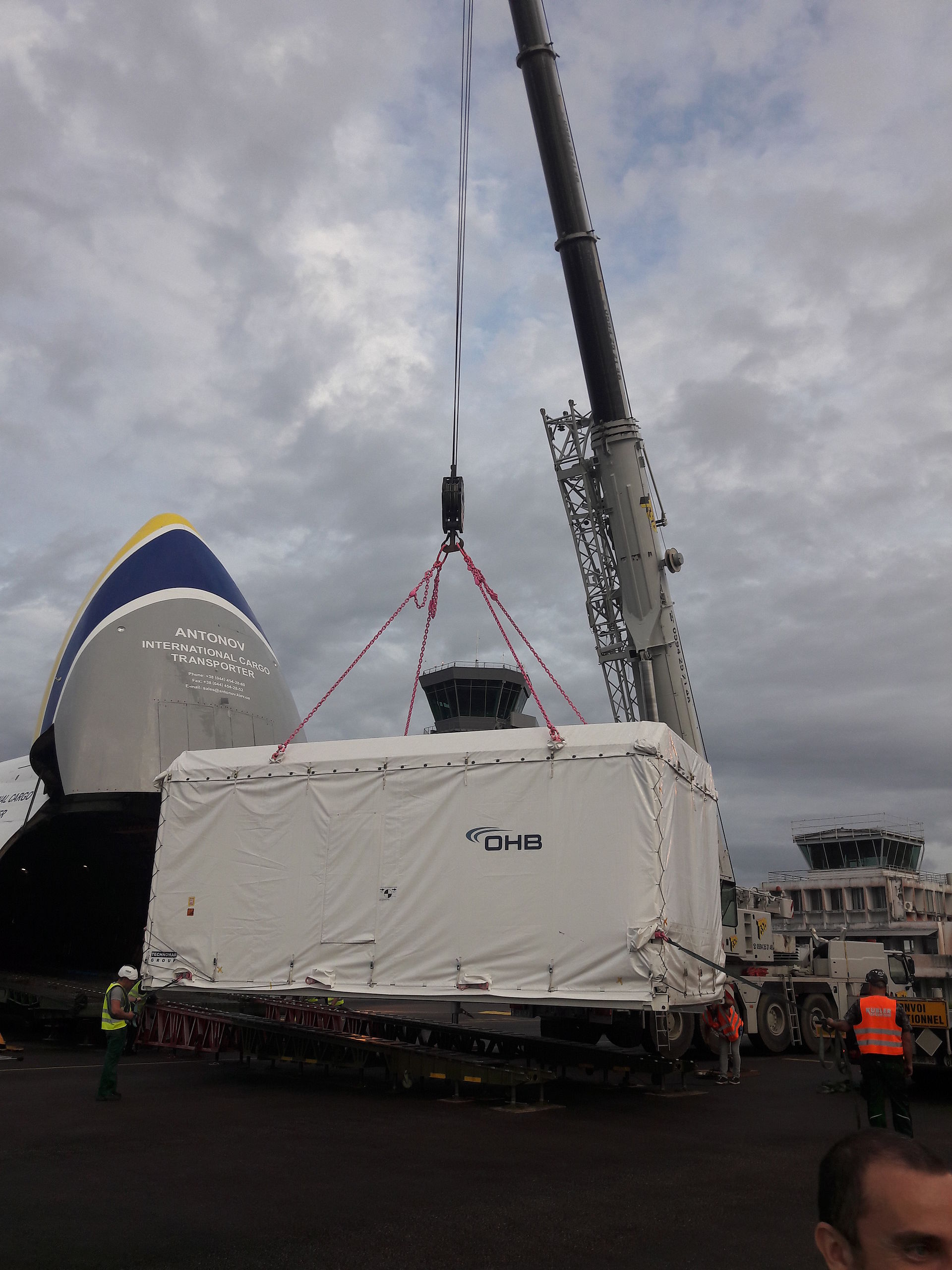Kourou, French Guiana, June 21, 2019. The telecommunications satellite EDRS-C is the second node of the ‘SpaceDataHighway’ network (also known as EDRS). The SpaceDataHighway has arrived at the European launch site in Kourou, French Guiana. The EDRS-SpaceDataHighway is the European laser-based data relay system will establish a new standard in space-based communication. It is a public-private partnership between the European Space Agency (ESA) and Airbus Defence and Space.
OHB System AG was selected as the principal contractor for the development and manufacturing of the telecommunication satellite EDRS-C. EDRS-C will become part of the satellite constellation for the world’s first “optical fibre in the sky” that is based on cutting-edge laser technology.
The satellite EDRS-C is based on OHB’s proven SmallGEO satellite platform developed as part of ESA’s programme of Advanced Research in Telecommunications Systems (ARTES) program. “We adjusted the satellite design in order to meet the special and demanding requirements of the optical payload and extended the modular TM/TC subsystem to allow operation in the S and Ka bands. In addition, we installed secure encryption electronics,” explained Dr Stefan Voegt, EDRS-C project manager at OHB System AG.
The first major leg of a rather long journey to work
Securely stowed in a container, EDRS-C has completed the first legs of its journey to its destined place in space some 36,000 kilometres above Earth: On June 17th, the satellite was placed in the special air-conditioned container that protected the satellite during its journey from Munich to Europe’s Spaceport in Kourou, French-Guiana. Further containers were loaded with equipment (e.g. electrical and mechanical ground support equipment and many other tools) which the OHB experts will need to complete their work during the remaining weeks up to launch. Means of transportation was an Antonov-124 aircraft. After a stop-over at Cabo Verde, the Antonov touched down at Cayenne airport in French Guiana on the evening of June 19. The containers arrived at the European launch site in Kourou on June 20, 2019. Of course, some of the OHB engineers were on board the Antonov to accompany the precious freight to Kourou. Others arrived earlier to make preparations for a smooth entry and to unpack the satellite in the clean room at the launch site.
Testing continues
Over the past months, the satellite was thoroughly checked in the course of the comprehensive environmental test campaign – e.g. in a space simulation chamber, in vibration and acoustic laboratories and in a CATR facility. All this is to ensure that the satellite will withstand the stresses and strains that it will be subjected to during launch and the harsh conditions in space.
There is more testing planned for EDRS-C: “First of all, we want to make sure that our satellite survived the voyage well; that’s why we will continue to carry out various tests" says Roberto Montedori from OHB System AG who is responsible for the EDRS-C launch site activities. “Accommodating our satellite on the launcher will be another very special moment for us prior to launch. We have a tight schedule until then, but we are familiar with the proceedings at the launch site and can rely on the experts here.”
Leaving Earth for good in July
The satellite is scheduled for launch on 24th July 2019 on an Ariane 5. The satellite’s operational position is at 31° East. The geostationary position allows data from LEO satellites equipped with dedicated laser terminals to be accessed by the end users in close to real time.
About EDRS-SpaceDataHighway
It will be a unique system of satellites in an orbit that makes them appear to be permanently "fixed" over a network of ground stations. The system is designed to relay data between Earth Observation satellites in Low Earth Orbit (LEO) as well as drones and aircrafts and the EDRS satellites in geostationary orbit using innovative laser communication technology. It then sends the data down to ground stations based in Europe. For the inter-satellite link between LEO satellites and the EDRS satellites, laser communication terminals are used for high data rate requirements, while a set of Ka-band RF terminals is used for the high data rate links between the EDRS satellites and the ground stations.
Team effort
OHB developed and built the satellite under a contract with Airbus Defence and Space. Aboard the satellite is a data relay payload with a laser communications terminal for satellite-to-satellite links supplied by the German partner Tesat-Spacecom. In addition, a hosted payload HYLAS 3 was provided by Avanti Communications under a contract with ESA as a customer-furnished item to OHB. EDRS-SpaceData-Highway is supported by the German Space Administration at DLR with funding from the Federal Ministry of Economic Affairs and Energy (BMWi) and the Federal State of Bavaria. Three sister companies were involved in EDRS-C: OHB Sweden was in charge of the AOCS subsystem, LuxSpace contributed to the TT&R subsystem which transmits information on the conditions of vital satellite systems to the ground stations and MT Aerospace delivered the satellite structure panels.
SmallGeo – a versatile satellite platform
Further SmallGEO projects in the conventional telecommunications segment include Heinrich Hertz (in-orbit verification of numerous national scientific and technical innovations as well as satellite communications for the German federal armed forces). Europe’s future fleet of weather satellites, the Meteosat Third Generation EUMETSAT satellites, is also based on the SmallGEO satellite platform.
Contact for media representatives:
Marianne Radel
Head of Corporate Communications
Phone: +49 421 2020 9159
Email: marianne.radel@ohb.de
Contact for investors and analysts:
Marcel Dietz
Investor Relations
Phone: +49 421 2020 6426
Email: ir@ohb.de


